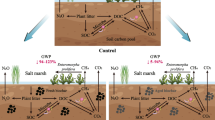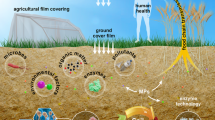Abstract
The effects of Fire Phoenix (a mixture of Festuca L.) and Purple coneflower (Echinacea purpurea (L.) Moench) on the remediation of two different high concentrations of PAH-contaminated soils were studied under the effect of strain N12 (Mycobacterium sp.), and the changes in rhizosphere enzymatic activity were preliminarily studied. The results of three culture stages (60 d, 120 d, and 150 d) showed that N12 has a promotional effect on the biomass of Fire Phoenix and E. purpurea, and the effect of N12 on the biomass of Fire Phoenix is better. Under the strengthening of N12, the maximum removal rates of Fire Phoenix reached 86.77% and 67.82% at two high PAH concentrations (A and B, respectively). The activity of dehydrogenase (DHO) is positively correlated with the degradation rate of PAHs at the A concentration (P < 0.05). The activity of DHO in soil will continue to increase at a higher level of the B concentration, but the positive correlation between the activity of DHO and the degradation rate of PAH is weakened. In the rhizosphere soil of the two plants, the change in polyphenol oxidase (PPO) activity with time has a significant negative correlation with the degradation rate of PAHs (P < 0.05). The experiment proved that Fire Phoenix is more suitable for the remediation of heavy PAH-contaminated soil under the condition of microorganism-strengthening, and it can achieve a better degradation effect when the concentrations of PAHs are < 150 mg·kg−1. Results provide a further scientific basis for the remediation of contaminated sites.








Similar content being viewed by others
References
Abhilash PC, Srivastava S, Srivastava P, Singh B, Jafri A, Singh N (2011) Influence of rhizospheric microbial inoculation and tolerant plant species on the rhizoremediation of lindane. Environ Exp Bot 74:127–130
Agnello AC, Bagard M, van Hullebusch ED, Esposito G, Huguenot D (2016) Comparative bioremediation of heavy metals and petroleum hydrocarbons co-contaminated soil by natural attenuation, phytoremediation, bioaugmentation and bioaugmentation-assisted phytoremediation. Sci Total Environ 563:693–703
Amezcua-Allieri MA, Avila-Chavez MA, Trejo A, Melendez-Estrada J (2012) Removal of polycyclic aromatic hydrocarbons from soil: a comparison between bioremoval and supercritical fluids extraction. Chemosphere 86:985–993
Andreolli M, Lampis S, Poli M, Gullner G, Biro B, Vallini G (2013) Endophytic Burkholderia fungorum DBT1 can improve phytoremediation efficiency of polycyclic aromatic hydrocarbons. Chemosphere 92:688–694
Aslantas R, Cakmakci R, Sahin F (2007) Effect of plant growth promoting rhizobacteria on young apple tree growth and fruit yield under orchard conditions. Sci Hortic-Amsterdam 111:371–377
Baran S, Bielinska JE, Oleszczuk P (2004) Enzymatic activity in an airfield soil polluted with polycyclic aromatic hydrocarbons. Geoderma 118:221–232
Belimov AA, Dodd IC, Hontzeas N, Theobald JC, Safronova VI, Davies WJ (2009) Rhizosphere bacteria containing 1-aminocyclopropane-1-carboxylate deaminase increase yield of plants grown in drying soil via both local and systemic hormone signalling. New Phytol 181:413–423
Chen J, Xue QH, McErlean CSP, Zhi JH, Ma YQ, Jia XT, Zhang M, Ye XX (2016) Biocontrol potential of the antagonistic microorganism Streptomyces enissocaesilis against Orobanche cumana. Biocontrol 61:781–791
Chen Y, Wang CX, Wang ZJ, Huang SB (2004) Assessment of the contamination and genotoxicity of soil irrigated with wastewater. Plant Soil 261:189–196
Falciglia PP, De Guidi G, Catalfo A, Vagliasindi FGA (2016) Remediation of soils contaminated with PAHs and nitro-PAHs using microwave irradiation. Chem Eng J 296:162–172
Gan S, Lau EV, Ng HK (2009) Remediation of soils contaminated with polycyclic aromatic hydrocarbons (PAHs). J Hazard Mater 172:532–549
Gao YC, Wang JN, Xu JB, Kong X, Zhao L, Zeng DH (2013) Assessing the quality of oil-contaminated saline soil using two composite indices. Ecol Indic 24:105–112
Gao YZ, Li QL, Ling WT, Zhu XZ (2011) Arbuscular mycorrhizal phytoremediation of soils contaminated with phenanthrene and pyrene. J Hazard Mater 185:703–709
Garcia-Sanchez M, Kosnar Z, Mercl F, Aranda E, Tlustos P (2018) A comparative study to evaluate natural attenuation, mycoaugmentation, phytoremediation, and microbial-assisted phytoremediation strategies for the bioremediation of an aged PAH-polluted soil. Ecotox Environ Safe 147:165–174
Gianfreda L, Rao MA, Piotrowska A, Palumbo G, Colombo C (2005) Soil enzyme activities as affected by anthropogenic alterations: intensive agricultural practices and organic pollution. Sci Total Environ 341:265–279
Glaser K, Hackl E, Inselsbacher E, Strauss J, Wanek W, Zechmeister-Boltenstern S, Sessitsch A (2010) Dynamics of ammonia-oxidizing communities in barley-planted bulk soil and rhizosphere following nitrate and ammonium fertilizer amendment. FEMS Microbiol Ecol 74:575–591
Gray EJ, Smith DL (2005) Intracellular and extracellular PGPR: commonalities and distinctions in the plant-bacterium signaling processes. Soil Biol Biochem 37:395–412
Guan S (1986) Soil enzymes and research methods. China Agricultural Science Press, Beijing, pp 274–323 (in Chinese)
Hu F, Su Z, Sun J, Li X, Zhang H, Sun J (2011) Isolation and identification of a highly efficient pyrene-degrading Mycobacterium sp. strain N12. Chin J Appl Ecol 22:1566–1572 (in Chinese)
Innemanova P, Filipova A, Michalikova K, Wimmerova L, Cajthaml T (2018) Bioaugmentation of PAH-contaminated soils: a novel procedure for introduction of bacterial degraders into contaminated soil. Ecol Eng 118:93–96
Joner EJ, Johansen A, Loibner AP, Dela Cruz MA, Szolar OHJ, Portal JM, Leyval C (2001) Rhizosphere effects on microbial community structure and dissipation and toxicity of polycyclic aromatic hydrocarbons (PAHs) in spiked soil. Environ Sci Technol 35:2773–2777
Juwarkar AA, Jambhulkar HP (2008) Phytoremediation of coal mine spoil dump through integrated biotechnological approach. Bioresour Technol 99:4732–4741
Kaimi E, Mukaidani T, Miyoshi S, Tamaki M (2006) Ryegrass enhancement of biodegradation in diesel-contaminated soil. Environ Exp Bot 55:110–119
Khanjari Y, Eikani MH, Rowshanzamir S (2016) Remediation of polycyclic aromatic hydrocarbons from soil using superheated water extraction. J Supercrit Fluids 111:129–134
Kong FX, Sun GD, Liu ZP (2018) Degradation of polycyclic aromatic hydrocarbons in soil mesocosms by microbial/plant bioaugmentation: performance and mechanism. Chemosphere 198:83–91
Kukla M, Plociniczak T, Piotrowska-Seget Z (2014) Diversity of endophytic bacteria in Lolium perenne and their potential to degrade petroleum hydrocarbons and promote plant growth. Chemosphere 117:40–46
Lee SH, Lee WS, Lee CH, Kim JG (2008) Degradation of phenanthrene and pyrene in rhizosphere of grasses and legumes. J Hazard Mater 153:892–898
Liu B, Li YX, Gao SY, Chen XC (2017a) Copper exposure to soil under single and repeated application: selection for the microbial community tolerance and effects on the dissipation of antibiotics. J Hazard Mater 325:129–135
Liu R, Xiao N, Wei SH, Zhao LX, An J (2014) Rhizosphere effects of PAH-contaminated soil phytoremediation using a special plant named Fire Phoenix. Sci Total Environ 473:350–358
Liu R, Dai YY, Sun LB (2015) Effect of rhizosphere enzymes on phytoremediation in PAH-contaminated soil using five plant species. PLoS One 10:e0120369
Liu SS, Lu YX, Yang C, Liu CP, Ma L, Dang Z (2017b) Effects of modified biochar on rhizosphere microecology of rice (Oryza sativa L.) grown in As-contaminated soil. Environ Sci Pollut R 24:23815–23824
Lu YF, Lu M (2015) Remediation of PAH-contaminated soil by the combination of tall fescue, arbuscular mycorrhizal fungus and epigeic earthworms. J Hazard Mater 285:535–541
Margesin R, Zimmerbauer A, Schinner F (2000) Monitoring of bioremediation by soil biological activities. Chemosphere 40:339–346
Perez-Hernandez I, Ochoa-Gaona S, Schroeder RHA, Rivera-Cruz MC, Geissen V (2013) Tolerance of four tropical tree species to heavy petroleum contamination. Water Air Soil Pollut 224:1637
Prapagdee B, Chanprasert M, Mongkolsuk S (2013) Bioaugmentation with cadmium-resistant plant growth-promoting rhizobacteria to assist cadmium phytoextraction by Helianthus annuus. Chemosphere 92:659–666
Rajamanickam S, Karthikeyan G, Kavino M, Manoranjitham SK (2018) Biohardening of micropropagated banana using endophytic bacteria to induce plant growth promotion and restrain rhizome rot disease caused by Pectobacterium carotovorum subsp carotovorum. Sci Hortic-Amsterdam 231:179–187
Ryu CM, Hu CH, Locy RD, Kloepper JW (2005) Study of mechanisms for plant growth promotion elicited by rhizobacteria in Arabidopsis thaliana. Plant Soil 268:285–292
Shi W, Zhang XN, Jia HB, Feng SD, Yang ZX, Zhao OY, Li YL (2017) Effective remediation of aged HMW-PAHs polluted agricultural soil by the combination of Fusarium sp and smooth bromegrass (Bromus inermis Leyss.). J Integr Agric 16:199–209
Sikora RA, Schafer K, Dababat AA (2007) Modes of action associated with microbially induced in planta suppression of plant-parasitic nematodes. Australas Plant Path 36:124–134
Smith MJ, Flowers TH, Duncan HJ, Saito H (2011) Study of PAH dissipation and phytoremediation in soils: comparing freshly spiked with weathered soil from a former coking works. J Hazard Mater 192:1219–1225
Sun Y, Gong Z, Su Z, Jin J, Li X, Liu W, Li P (2011) Identification and degradation characteristics of a bacteria strain degrading high concentration of polycyclic aromatic hydrocarbons. Chin J Ecol 30:2503–2508 (in Chinese)
Teng Y, Shen YY, Luo YM, Sun XH, Sun MM, Fu DQ, Li ZG, Christie P (2011) Influence of Rhizobium meliloti on phytoremediation of polycyclic aromatic hydrocarbons by alfalfa in an aged contaminated soil. J Hazard Mater 186:1271–1276
Tokala RK, Strap JL, Jung CM, Crawford DL, Salove MH, Deobald LA, Bailey JF, Morra MJ (2002) Novel plant-microbe rhizosphere interaction involving Streptomyces lydicus WYEC108 and the pea plant (Pisum sativum). Appl Environ Microbiol 68:2161–2171
Van der Waarde JJ, Dijkhuis EJ, Hessen MJC, Keuning S. (1995) Enzyme assays as indicators for biodegradation. In: van der Brick WJ, Bosman R, Arendt F, editors. Contam soil, pp. 1377–1378
Wang CY, Wang F, Wang T, Bian YR, Yang XL, Jiang X (2010) PAHs biodegradation potential of indigenous consortia from agricultural soil and contaminated soil in two-liquid-phase bioreactor (TLPB). J Hazard Mater 176:41–47
Wise SA, Sander LC, Schantz MM (2015) Analytical methods for determination of polycyclic aromatic hydrocarbons (PAHs) - a historical perspective on the 16 US EPA priority pollutant PAHs. Polycycl Aromat Compd 35:187–247
Xiao N, Liu R, Jin CX, Dai YY (2015) Efficiency of five ornamental plant species in the phytoremediation of polycyclic aromatic hydrocarbon (PAH)-contaminated soil. Ecol Eng 75:384–391
Xiao R, Bai JH, Wang JJ, Lu QQ, Zhao QQ, Cui BS, Liu XH (2014) Polycyclic aromatic hydrocarbons (PAHs) in wetland soils under different land uses in a coastal estuary: toxic levels, sources and relationships with soil organic matter and water-stable aggregates. Chemosphere 110:8–16
Xie Y, Fan JB, Zhu WX, Amombo E, Lou YH, Chen L, Fu JM (2016) Effect of heavy metals pollution on soil microbial diversity and Bermuda grass genetic variation. Front Plant Sci 7:755
Xu Y, Sun GD, Jin JH, Liu Y, Luo M, Zhong ZP, Liu ZP (2014) Successful bioremediation of an aged and heavily contaminated soil using a microbial/plant combination strategy. J Hazard Mater 264:430–438
Ye JS, Yin H, Peng H, Bai JQ, Li YP (2014) Pyrene removal and transformation by joint application of alfalfa and exogenous microorganisms and their influence on soil microbial community. Ecotox Environ Safe 110:129–135
Yonghai J, Shangzheng WEI, Beidou XI, Huayong Z, Hongjiang LI (2009) Polycyclic aromatic hydrocarbons(PAHs) pollution in soils in China: recent advances and future prospects. Ecol Environ 18:1176–1181 (in Chinese)
Yu XZ, Wu SC, Wu FY, Wong MH (2011) Enhanced dissipation of PAHs from soil using mycorrhizal ryegrass and PAH-degrading bacteria. J Hazard Mater 186:1206–1217
Yu Y, Zhang W, Chen GH, Gao YC, Wang JN (2014) Preparation of petroleum-degrading bacterial agent and its application in remediation of contaminated soil in Shengli oil field, China. Environ Sci Pollut R 21:7929–7937
Zhang M, Xu LH, Lee SS, Ok YS (2016) Sorption of polycyclic aromatic hydrocarbons (PAHs) by dietary fiber extracted from wheat bran. Chem Speciat Bioavailab 28:13–17
Zhou LK (1987) The science of soil enzyme. The Science Press, Beijing, pp 267–270 (in Chinese)
Zhou QX, Cheng Y, Zhang QR, Liang JD (2004) Quantitative analyses of relationships between ecotoxicological effects and combined pollution. Sci China Ser C 47:332–339
Zhou QX, Sun FH, Liu R (2005) Joint chemical flushing of soils contaminated with petroleum hydrocarbons. Environ Int 31:835–839
Funding
This work was financially supported by two general projects of the National Natural Science Foundation of China (grant nos. 31470547, 31770545).
Author information
Authors and Affiliations
Corresponding author
Additional information
Responsible editor: Elena Maestri
Publisher’s note
Springer Nature remains neutral with regard to jurisdictional claims in published maps and institutional affiliations.
Rights and permissions
About this article
Cite this article
Hou, L., Liu, R., Li, N. et al. Study on the efficiency of phytoremediation of soils heavily polluted with PAHs in petroleum-contaminated sites by microorganism. Environ Sci Pollut Res 26, 31401–31413 (2019). https://doi.org/10.1007/s11356-019-05828-1
Received:
Accepted:
Published:
Issue Date:
DOI: https://doi.org/10.1007/s11356-019-05828-1




